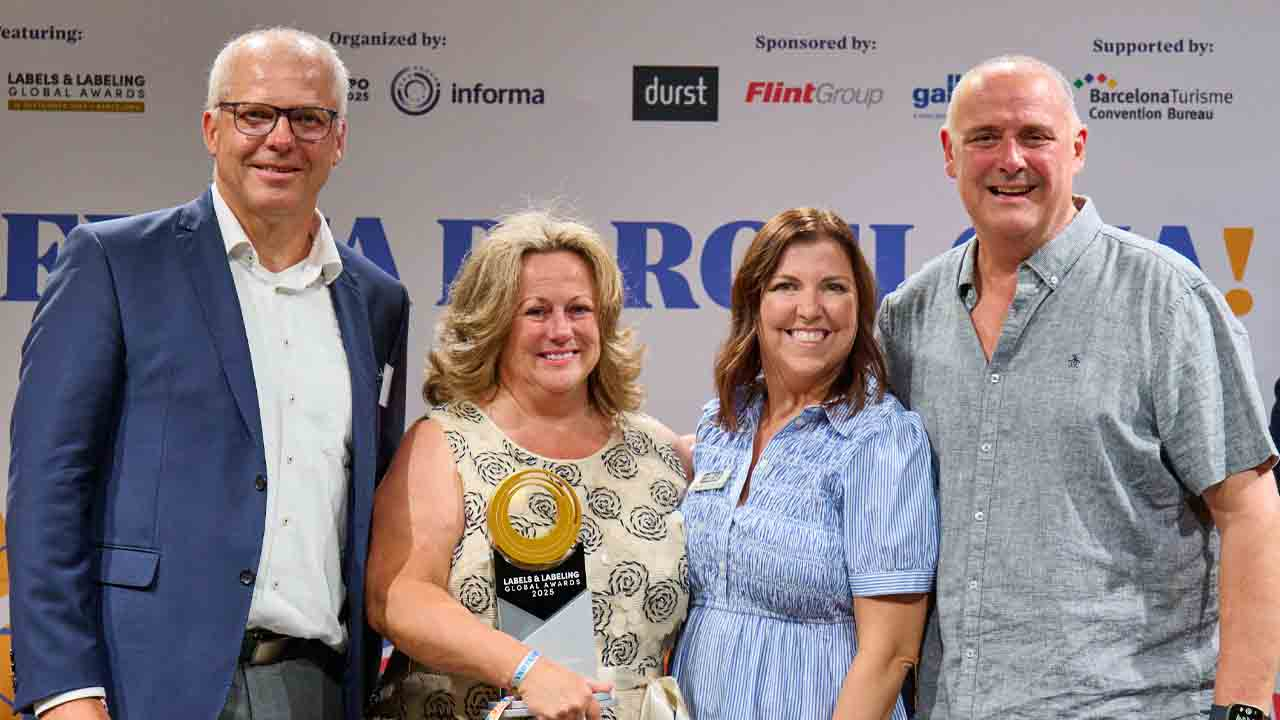Perfecting the wine label
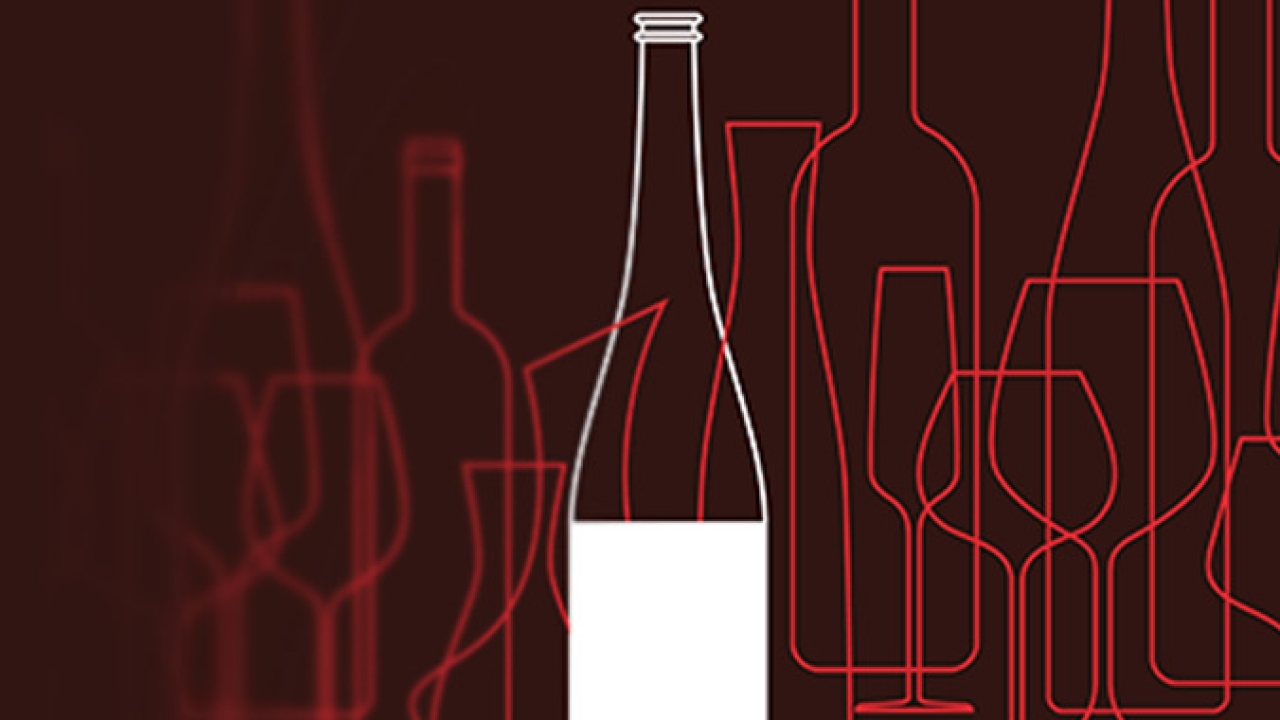
‘Research shows that 64 percent of consumers try new products because the packaging catches their eye,’ says Vanita Marzette, senior product manager for wine and spirits at Avery Dennison. ‘You have about three seconds to catch a consumer's eye at the shelf, which makes packaging and label design crucial. Choosing label materials that help you stand out can greatly impact whether a consumer grabs your bottle.’
However, according to a recent wine market survey, 36 percent of US consumers said they are confused by wine labels. Seventy-five percent said that even when they like a wine, they usually can't remember its name. More than half of those surveyed said they find wines with humorous labels appealing, and 81 percent said they want clear and easy-to-understand labels.
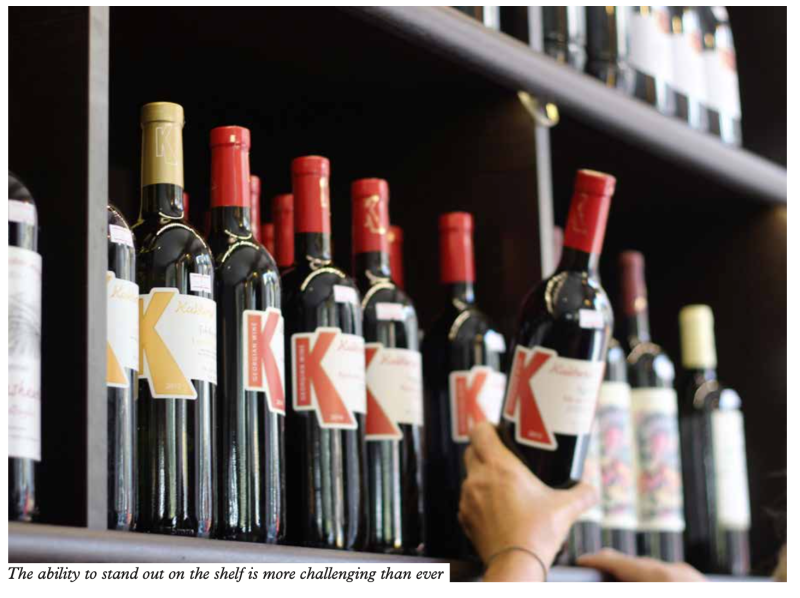 ‘The perfect wine label represents the brand authentically and speaks to the consumer in a language they understand,’ says Matthias Vollherbst, managing owner of Germany-based Vollherbst, which works closely with wineries around the globe to produce striking and memorable wine labels.
‘The perfect wine label represents the brand authentically and speaks to the consumer in a language they understand,’ says Matthias Vollherbst, managing owner of Germany-based Vollherbst, which works closely with wineries around the globe to produce striking and memorable wine labels.
‘Reports often say that a specific design style and specific colors sell better – such as a black paper with gold foil and embossing. This is probably true if you look at the wine market in general. But every wine and, therefore, every brand and label are unique and general rules rarely apply to them – that is what makes wine marketing so interesting and fascinating,’ adds Vollherbst.
It’s about understanding the people behind a brand, their values, and the values they are seeking to share, says Vollherbst.
‘Unlike other categories, like food, the wine label has a much more difficult task. It needs to describe the taste and the personality of the wine without showing it or using obvious cliches. It’s a bit like the perfume industry: the design must make you feel rather than see,’ adds Giuseppe Mascia, visual design lead at Milan-based branding agency CBA Design, who has completed several projects in the wine and spirits space. ‘The perfect label can tell a story and create an intimate connection between the wine and the consumer. Of course, different markets need different approaches. The New World wines are usually less related to ancient traditions than the Italian or French ones, so they can be bolder and more expressive.’
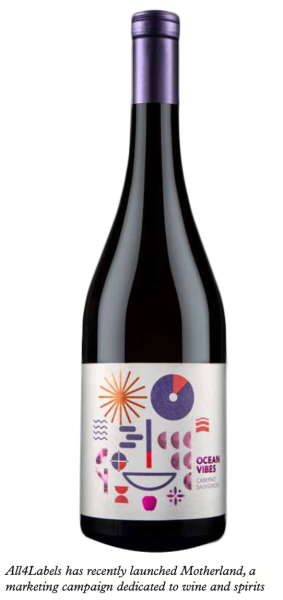 Global converting group All4Labels has recently launched Motherland, a marketing campaign dedicated to wine and spirits that displays each product's unique essence and shows off its local heritage through eye-catching label designs. In the coming months, the group will produce eight label concepts for wine and spirits from Argentina, France, Italy, South Africa, Mexico, Russia, China and Germany.
Global converting group All4Labels has recently launched Motherland, a marketing campaign dedicated to wine and spirits that displays each product's unique essence and shows off its local heritage through eye-catching label designs. In the coming months, the group will produce eight label concepts for wine and spirits from Argentina, France, Italy, South Africa, Mexico, Russia, China and Germany.
‘We are embarking on this campaign to highlight our presence as a main player in the wine and spirits market and to show our high premium solutions,’ says Adrian Tippenhauer, CEO of All4Labels. ‘Motherland will demonstrate in very real terms how All4Labels is pioneering innovation with bold creativity, high quality and sustainable packaging for local and global wine and spirits brands.’
‘Setting the standards of perfect labels is a question of sensitivity, as we need to connect with the time we live, and to link our capabilities together with the instances of the regional regulations and the changing demands of the end-users,’ adds Paola Iannone, vice president of marketing and communications at All4Labels. ‘It requires a deep connection with the industry in which we act and strong sociological know-how to interpret reality with extreme fluidity, accordingly to the trends of the moment.’
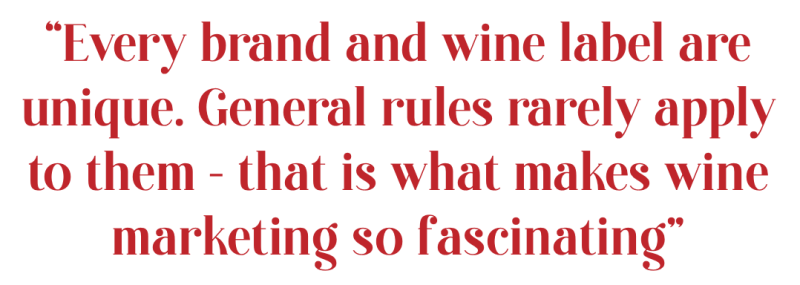 In a retail environment, the label is crucial when consumers make a purchasing decision. But, how to develop a label that will not only stand out on a crowded shelf but also build an intimate relationship and engrave the brand identity in the consumer’s memory?
In a retail environment, the label is crucial when consumers make a purchasing decision. But, how to develop a label that will not only stand out on a crowded shelf but also build an intimate relationship and engrave the brand identity in the consumer’s memory?
‘Decorative design elements such as foil, screen ink and interesting label shapes accomplish this task,’ answers Darren Hudson, president of Multi-Color Corporation in Australia and New Zealand, the region placed in the top 10 wine producers globally. ‘Once seen, it must invite tactile engagement, so it is picked up. This is achieved by incorporating texture into a paper label or selecting a unique material such as felt. Lastly, the label is a visual cue of quality and value. A well-designed and printed label foretells the premium experience the consumer can look forward to.’
‘There are also values attached to the wine industry, like history, culture, comfort, a certain image of sociality, but also sustainability. A label is then the main way to convey a message and these values, whether by the material, by the embellishment, and by design: a simple chateau design, the reproduction of a work of art, or even a graffiti,’ suggests Louis Rouhaud, global marketing director of Arjobex Synthetic Paper, part of Polyart Group, who often helps wineries and printers to create branding experience suitable for the wine and region it represents.
‘I always find this to be a great question as many would assume it is the best design, the most intricate label, or a highly embellished label,’ says Kevin Frydryk, vice president responsible for markets and products at US-based Resource Label Group, who oversees the development of wine labels. ‘I believe the perfect wine label considers the total package and finds the right intersection between the story the brand wants to tell and the image they want to create to maximize the experience for the customer. The product can be limitless as that story may translate into a highly decorated label or something straightforward.’
Design evolution
To better understand what makes the perfect wine label today, we can consider its evolution over the past few years.
‘There has been a revolution in the winemaking as volumes had been stalling, and producers had to venture to other consumer populations,’ explains Polyart’s Rouhaud. ‘This has been impacting the labels. The wine industry opened itself to new markets, new generations and new countries. And thus, labels have accompanied this change with different substrates and designs: to appeal to young consumers, they couldn’t use the traditional chateau label. They had to appeal to different values and cultures of those new target markets.’
Ten years ago, premium wine labels were printed on an uncoated material with a more natural look and feel, some metallic effects, high build varnish, preferably on the brand name and key brand elements. These effects are standard on today’s wine labels.
‘Two major developments have led to what is often described as premiumization in wine packaging: first, the understanding of consumers and brand owners that wine is a luxury good where people want to treat themselves and experience consumption as a pleasure,’ Vollherbst. ‘Secondly, the ever more efficient and increasingly sophisticated materials and finishing options mean that ever more extraordinary visual and tactile effects can be achieved within a reasonable budget.’
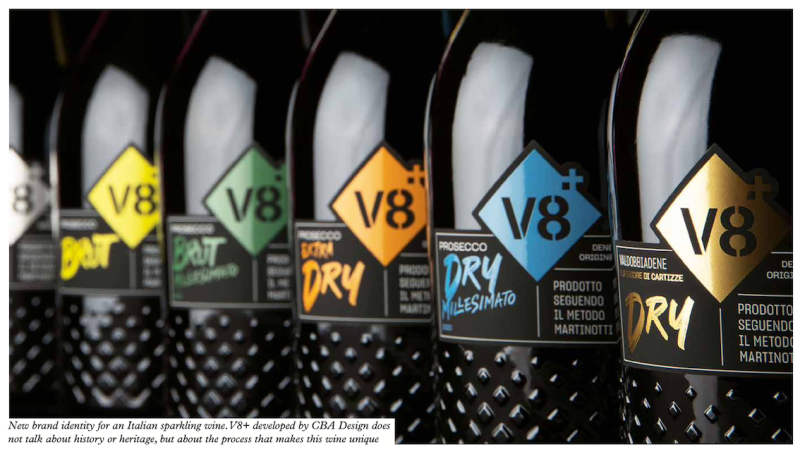
‘The printing technologies and innovative materials have given new opportunities to the design,’ agrees CBA Design’s Mascia. ‘Having said that, I guess what has not changed (and will not in the future) are the emotions a label must bring. You can change the frame, but not the painting.’
Multi-Color Corporation (MCC) wine labeling specialists note that stocks and embellishments have gone to the next level in the last decade and continue to evolve. There is more diversity in design, using digital print technology for variable images and consumer engagement features such as augmented reality or QR codes and moving away from traditional stocks and embellishments to engage a younger demographic.
‘Over the past ten years, it has been increasingly difficult to stand out on the shelf, which has increased decorative effects such as foil embossing and technologies such as QR codes and augmented reality,’ confirms Bill Knopka, vice president of sales and marketing for wine and spirits at MCC North America.
‘Labels have gotten more complex,’ admits Avery Dennison’s Marzette. ‘You may not be able to notice right away, but when you see that subtle glimmer of foil or feel the raised clear varnish, the label execution is more complex than it was 10 years ago. Materials have also evolved from different shades of white with deckled edges to an array of bright colors made from high quality facestocks.’
 Resource Labels Group’s Frydryk also noticed that wine labels have evolved significantly over the past few years, changing from traditional design to a true brand extension. Highly decorated labels were once considered to be exclusive to high-end wines. Those requirements are now across all price points. Storytelling through design or packaging is one of the most significant changes he has seen. What used to be a straightforward substrate selection or foil enhancement has evolved into non-traditional embellishments and unique substrates.
Resource Labels Group’s Frydryk also noticed that wine labels have evolved significantly over the past few years, changing from traditional design to a true brand extension. Highly decorated labels were once considered to be exclusive to high-end wines. Those requirements are now across all price points. Storytelling through design or packaging is one of the most significant changes he has seen. What used to be a straightforward substrate selection or foil enhancement has evolved into non-traditional embellishments and unique substrates.
What’s trending
‘We can see the emergence of three main packaging trends: personalization, co-creation, and consumer interaction. Setting a brand experience through connected packaging is a big demand from brand owners. Consumer interaction is now adding a layer of experience to consumers’ purchases in many segments, and QR marketing is the key to a new world,’ says Nicolas Günther, general manager of the Smart+Secure division at All4Labels Group. ‘Our QR Tags not only activate but unleash the full media, marketing, solutions, and analytics potential of a label. QR Tag solutions enable extended, multilingual, multi-amblyopia, multimedia content without using extra space instead of unveiling extra marketing space on the label. QR Tags hypercharge every marketing department by providing astonishing consumer insights and are the fuel cell of super optimized selling and cross-selling opportunities. QR Tag-charged labels are the cleaner version of “landscape” labels.’
In the age of lightning-fast information, digital marketing has established itself as one of the biggest revenue opportunities for businesses, adds All4Labels’ Paola Iannone. She thinks that whether a call-to-action is a special offer, loyalty coupon, sweepstake, recommendation, or how-to guide, the important thing is that each scan provides value to the target audience in the form of money, fun or information.
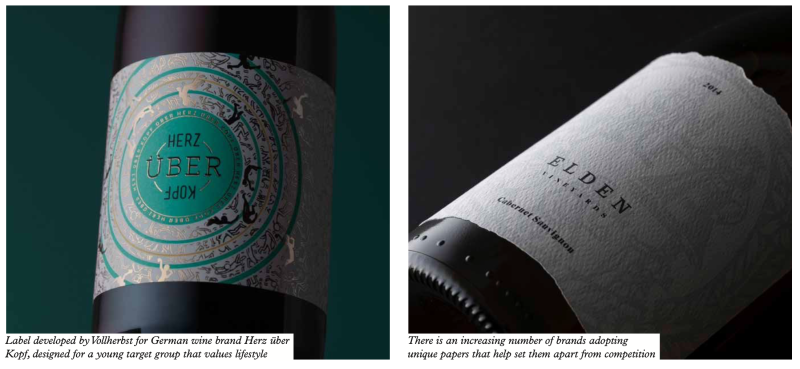
‘I guess the biggest opportunity is to design an ecosystem rather than just a label. If you have a story to tell, you can use multiple touchpoints to make it alive,’ agrees Giuseppe Mascia. ‘Doing it in the right way brings an incredible added value to the brands. The challenge is to keep a very high standard one every single touchpoint. Interactive labels are exciting, but they need to tell something more than the label itself and be relevant to the consumer. If it is just a matter of showing off the technology, it does not make sense. Unfortunately, brands often push for innovative solutions without a soul, not just in the wine and spirits sector.’
Digital printing is emerging as a key enabler of consumer interaction. ‘With digital printing, brands can use their packaging as a platform for storytelling, which evolves from a mere marketing prospective to a sharp brand position,’ says Massimiliano Martino, chief technology officer at All4Labels Group. ‘Use storytelling to supercharge wine and spirits is enhanced by digital transformation.’
‘Interactive labels present an excellent opportunity for winemakers to connect directly with consumers, particularly if done as part of a strategic campaign rather than just for the novelty factor,’ adds MCC’s Knopka. ‘Offering access to unique content can help build brand relationships and encourage loyalty, particularly for international markets.’
MCC says that there will be greater use of interactive technologies in wine packaging as wineries seek to connect with their customers and drive repeat purchases more intimately.

‘There have been great recent examples of this. The 19 Crimes line-up [see boxout] does a very nice job using augmented reality (AR). We’re getting more and more inquiries around near-field communication (NFC) technology. This technology physically implants an antenna in the label. When a smartphone comes into range of the label, the phone takes the consumer to a brand web page where more information about the wine is presented or promotions offered,’ comments MCC’s Hudson.
‘Not only using labels to make the brand story come to life with the use of NFC, but also the ability to track orders, validate varietals using blockchain technology,’ adds Avery Dennison’s Marzette. ‘Blockchain helps build transparency and trust between the producer and the end consumer.’
German converter Vollherbst believes that cool technologies like augmented reality will have only a limited influence on wine marketing, despite their enormous potential.
Says Matthias Vollherbst, ‘Fancy animations attract interest from new consumer groups who may find wine too traditional. Interactive menus can foster interaction between consumers and wine brands. Sounds, real voices and videos can increase credibility and give consumers a face to the anonymous product.
‘Generally speaking, however, we perceive the wine category to be too traditional to be influenced by such trends. Trendy packaging is not something that most wine consumers want, and we saw many great, progressive and trendy packaging concepts fail – simply because consumers don’t understand or expect them on wine.
 ‘This is especially true in more traditional consumer markets like Germany, Switzerland or France. Here, you rather see mid to long-term developments that come into the game and stay for several years, like the use of uncoated materials or more colorful yet highly refined color foil finishes. Color-changing varnishes that show ideal wine drinking temperature is something that has also worked well recently as it is is easy to understand and delivers practical benefits to consumers.’
‘This is especially true in more traditional consumer markets like Germany, Switzerland or France. Here, you rather see mid to long-term developments that come into the game and stay for several years, like the use of uncoated materials or more colorful yet highly refined color foil finishes. Color-changing varnishes that show ideal wine drinking temperature is something that has also worked well recently as it is is easy to understand and delivers practical benefits to consumers.’
‘There are an increasing number of brands that are adopting more unique papers that help set them apart,’ adds Avery Dennison’s Marzette. ‘They are using glossy papers like we have in our luminous collection in addition to papers with tactile finishes like you would find in our sensorial collection.’
Vollherbst sees sustainability as another important development for wine labels. The company pioneeredcraftLabel, a method of adding natural resources like soil or sand into a label, offering wine producers the potential to tell the true brand story and bring it closer to consumers.
‘Winery owners and brand owners increasingly recognize the importance of utilizing sustainable packaging for their wines. They are requesting label materials with post-consumer waste and seeking assistance in recovering liner materials once bottling is complete,’ agrees MCC’s Hudson. ‘We are also seeing our customers request ways to reduce the number of materials used. We help them by suggesting smaller label sizes in ways that do not negatively impact the brand image. This also saves money.’
Sustainable materials are becoming more popular as consumers demand sustainability from brands.
‘There has been an increase in requests for materials that are FSC, recyclable or made from organic materials that are sourced in a responsible manner. Avery Dennison has met these needs with sustainable options that have 30 to 100 percent recycled content in addition to including material made from cotton, citrus, hemp and barley,’ says Marzette.
‘We’ve seen trends on textured substrates, also on durability (resistance to ice bucket); we’ve seen labels with unique numbering or even bottles with unique label designs (with HP indigo Mosaic software design), but one of the trends that is coming through now is sustainability,’ agrees Polyart’s Rouhaud.
This trend has gone along with a move towards simplicity in design, adds CBA Design’s Giuseppe Mascia. ‘Even historical, well-established brands embrace the idea that less is more and having less cluttered design helps to go to the point.’
Opportunities and challenges
The task of good design is to translate the ideas, values and passions of winemakers into a visual language.
‘The essence and character of the winemaker is always in the foreground. One must avoid putting on expensive new clothes that do not fit them. They should be staged as they really are – with all their fascinating strengths and weaknesses,’ says Matthias Vollherbst.
‘Nobody can doubt the level of expertise needed to create a truly effective new packaging design. An ability to ‘wow’ consumers and customers is part of that expertise, but so is balancing a huge range of practical, cost, sustainability, and logistics issues,’ states Tobias Rug, head of All4Graphics, the design division of All4Labels Group.
‘Designers should forget about what has come before and work on a new blank canvas without restrictions while cooperating with label converters to unlock the extensive range of print innovations and capabilities,’ says MCC’s Knopka. ‘The ability to use multiple tactile elements starting from material selection to use of screens, foiling, sculptured embossing to present something beautiful not only to look at but to engage the sense of touch.’
However, as much as the increasing number of modern technologies, machinery, and available substrates can present enormous opportunities for wineries and designers, they can also quickly become a sea of chaos.
‘As a designer, the possibilities are endless. You can print on transparent labels, textured paper, hemp paper, and cotton paper. They are truly endless. Perhaps that’s why the biggest challenge is to choose,’ agrees Rouhaud.
‘The most recent challenge many businesses face is supply channel constraint,’ adds Kevin Frydryk. ‘It has really hit everyone across the board from the availability of material and inks to other packaging elements such as the availability of glass and other packaging materials. It is more critical than ever that designers and printers work together and adjust based on supply constraints. There is always a solution, it just may take some additional discussion to get to the right one based on the customer's needs.’
The next big thing
How to get ahead of the curve? We asked our respondents to pinpoint what might be the next big thing for the print industry serving wine label clients.
‘Digital finishing and metallization opportunities will become standard in the next years, allowing for even more individualization and personalization of wine labels. Sustainable material and finishing technologies will boom soon,’ answers Matthias Vollherbst without hesitation.
‘Finally, digital wine labels, be it for practical reasons to allow the consumer or trader to trace the supply chain – or for more fun related reasons like augmented reality, will be further pushed,’ he adds. However, the next big thing, surprisingly, could be a return of the traditional wine label, or something very similar. That is the beauty and secret of wine marketing.’
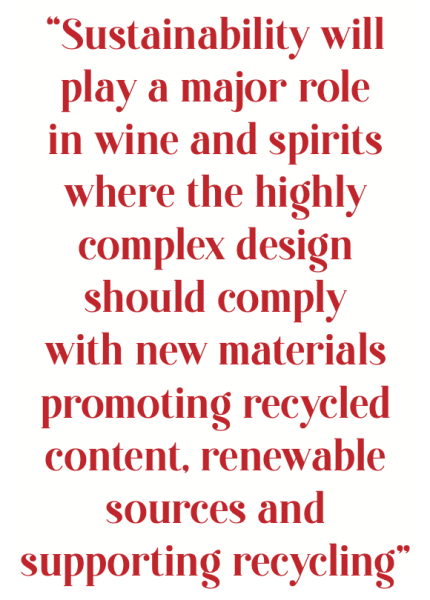 Polyart’s Louis Rouhaud thinks sustainability will be the prominent trend in the future. ‘Today, when you choose a material, you don’t only question its physical specs, whiteness, texture, durability to an ice bucket, or even its design… but you ask yourself what is its impact on the planet; what is its CO2 footprint? What can I say about my sustainability endeavor, and is it conveyed by the label? And that will be more and more part of the equation.’
Polyart’s Louis Rouhaud thinks sustainability will be the prominent trend in the future. ‘Today, when you choose a material, you don’t only question its physical specs, whiteness, texture, durability to an ice bucket, or even its design… but you ask yourself what is its impact on the planet; what is its CO2 footprint? What can I say about my sustainability endeavor, and is it conveyed by the label? And that will be more and more part of the equation.’
This approach is also echoed by the wine specialists from All4Labels Group, who think that designing packaging specifically to be recycled will become vital.
‘Packaging serves multiple functions – protecting and preserving products, differentiating and positioning brands and connecting with consumer values,’ adds Gabriela Neves, head of sustainability at All4Labels. ‘But we can foresee sustainability will play a major role even in wine and spirits where the highly complex design should comply with new materials promoting recycled content, renewable sources and supporting recycling with dedicate solutions.’
‘I think the number of SKUs and packaging options will continue to grow,’ adds Resource Labels Group’s Frydryk. ‘And as the demographic changes a bit towards the younger wine drinker, I believe we will see a change in design and delivery method as well as an emphasis on sustainability to complement the brand story.’
More luxurious materials married with sustainability is the future according to Avery Dennison’s Marzette. ‘You don’t have to choose between the two,’ she says. ‘Not only are labels becoming more sustainable, but brands are looking at overall packaging. Recycled glass, paper etc. in addition to boxes and other formats.’
What is clear is that wine packaging is a powerful tool that can change buying preferences and consumption patterns in significant ways.
For further info:
For more information, read the Label Academy’s ‘Label Embellishments and Special Applications: Exploring the techniques and processes used for adding decorative finishes and functionality to labels’ book, available on Amazon or through the Label Academy section of labelsandlabeling.com
Stay up to date
Subscribe to the free Label News newsletter and receive the latest content every week. We'll never share your email address.
